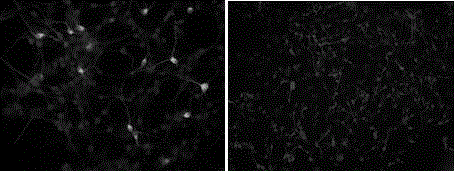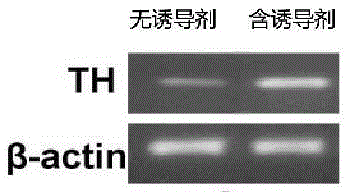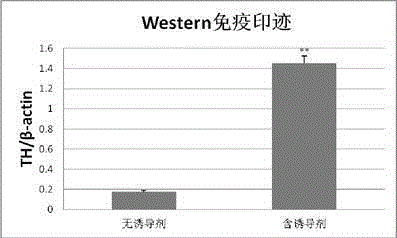Method for inducing differentiation of neural stem cells (NSCs) into dopaminergic neurons
A neural stem cell and dopaminergic technology, applied in the field of stem cell therapy, can solve the problem of low differentiation rate of dopamine neurons
- Summary
- Abstract
- Description
- Claims
- Application Information
AI Technical Summary
Problems solved by technology
Method used
Image
Examples
Embodiment 1
[0026] Implementation Example 1: Extraction of Forebrain Neural Stem Cells
[0027] This example uses the forebrain of aborted embryos authorized with donor consent as a source of neural stem cells.
[0028] Take a 12-week-old complete aborted embryo, wash it with HBSS (Hyclone) for several times, fix the head of the embryo, use small scissors to cut the entire cranial cavity at the foramen magnum to the occipital side, and gently remove the fetal brain with tweezers. The cranial cavity was peeled off, placed in a disposable sterile petri dish, and washed with a small amount of PBS (Hyclone) buffer. Peel off the meninges with fine forceps and remove the cerebellum. The midbrain and forebrain were separated at the peduncle of the brain, and after the forebrain was ground, the two were resuspended in a 50 mL centrifuge tube with a small amount of DMEM medium. After blowing evenly, filter the suspension with a 100um sieve, and then filter it with a 40um sieve. Centrifuge the f...
Embodiment 2
[0029] Implementation Example 2: Preparation of medium before and after NSC cell induction
[0030] Ordinary medium: NeuralBasal medium (Invitrogen), B27 (1:50, Invitrogen), bFGF (20ng / mL, R&D), EGF (20ng / mL, R&D), heparin sodium (5μg / ml, Changzhou Qianhong Biochemical) , L-Glutamine (2mM, Invitrogen)
[0031]Induction medium: NeuralBasal medium (Invitrogen), B27 (1:50, Invitrogen), fetal bovine serum (1%, Gibco), heparin sodium (5 μg / ml, Changzhou Qianhong Biochemical), L-glutamine (2mM, Invitrogen), TPA (phorbol12-myristate13-acetate, 100nM, sigma), Forskolin (25uM, sigma), acidicFGF (100ng / mL, R&D), BMP-7 (50ng / ml, sigma), pramipexole (10uM, sigma )
Embodiment 3
[0032] Implementation Example 3: Induced Differentiation of NSC Cells by Mixed Inducing Agents
[0033] NSC cells were cultured in the common medium mentioned in Example 2. When neurospheres with a diameter of 0.5 mm were formed, polylysine-coated coverslips were placed in 24-well plates, and 3-5 neurospheres and 1mL of the induction medium mentioned in Example 2, the neurospheres were added dropwise to the central area of the coverslip and cultured until the neurospheres adhered to the wall. The induction medium was changed every 2 days, and the dopaminergic neurons were detected after 6 days of culture.
PUM
 Login to View More
Login to View More Abstract
Description
Claims
Application Information
 Login to View More
Login to View More - R&D
- Intellectual Property
- Life Sciences
- Materials
- Tech Scout
- Unparalleled Data Quality
- Higher Quality Content
- 60% Fewer Hallucinations
Browse by: Latest US Patents, China's latest patents, Technical Efficacy Thesaurus, Application Domain, Technology Topic, Popular Technical Reports.
© 2025 PatSnap. All rights reserved.Legal|Privacy policy|Modern Slavery Act Transparency Statement|Sitemap|About US| Contact US: help@patsnap.com



